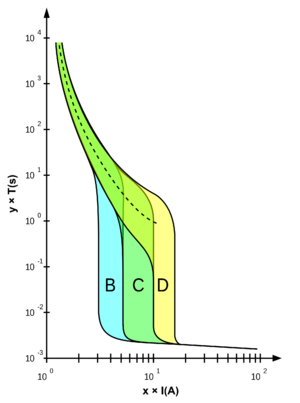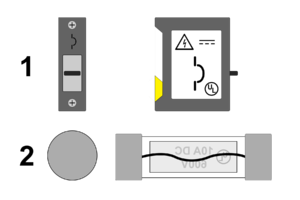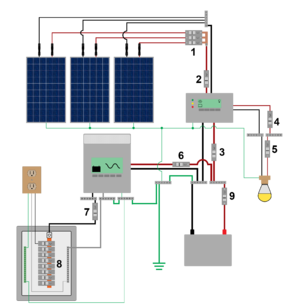Overcurrent protection device
All components of an electrical system have a maximum amount of current that they are rated to continuous handle, if this rating is exceeded excess heat will be generated which can result in a fire. Overcurrent protection devices (OCPDs) are used to automatically open (disconnect) a circuit if a certain current is reached for a certain period of time. The size of the required overcurrent protection device is determined by the maximum amount of current that a circuit is anticipated to carry and the size of the wiring in the circuit that it is protecting. The most common types of overcurrent protection device that are used in electrical systems are fuses and breakers.
The overcurrent protection devices for an off-grid system must will be sized and selected together with the conductor size of a circuit - see Wire, overcurrent protection, and disconnect sizing and selection for more information.
Contents
OCPDs in a stand-alone system
Each PV system will vary in terms of its OCPD needs both due to design and local requirements. The diagram at right depicts a hypothetical stand-alone system with DC lighting and an inverter for AC loads. It depicts many OCPDs that are commonly incorporated into an off-grid system, but simpler systems will not require as many and more complex systems will likely require additional OCPDs. Not all of the OCPDs in the diagram are completely necessary, it may be possible to omit some as they are already protected from excessive current by another OCPD. Any connections made directly to the energy storage system must be protected by an OCPD as the energy storage system can supply a tremendous amount of current in a short period of time. Many of these OCPDs depicted also serve as power source disconnects and equipment disconnects.
- PV source circuit OCPD
- PV output circuit OCPD
- Charge controller ouput circuit OCPD
- DC lighting output circuit OCPD
- DC branch circuit OCPD
- Inverter input circuit OCPD
- Inverter output circuit OCPD
- AC branch circuit OCPD
- Battery circuit OCPD
Characteristics
There are innumerable different OCPDs in the market with each one designed to fit a specific purpose. Many OCPDs are similar in appearance, therefore it is very important to revise the fine print on the side of any OCPD being considered to make sure that it is appropriate for the conditions of use.
Current type
OCPDs may be designed to work with AC, DC or both types of current. If a breaker is rated for both AC and DC, it is likely that the DC voltage rating will be lower as DC circuits are more difficult to interrupt.
Current rating

(B) (most sensitive), (C) (less sensitive), (D) (least sensitive).[1]
OCPDs will be rated for a specific continuous current rating.
- Standard international OCPD sizes: 1 A, 2 A, 4 A, 6 A, 10 A, 13 A, 16 A, 20 A, 25 A, 32 A, 40 A, 50 A, 63 A, 80 A, 100 A, 125 A, 150 A, 175 A, 200 A, 225 A, 250 A.
- Standard US OCPD sizes per US NEC: 15 A, 20 A, 25 A, 30 A, 35 A, 40 A, 45 A, 50 A, 60 A, 70 A, 80 A, 90 A, 100 A, 110 A, 125 A, 150 A, 175 A, 200 A, 225 A, 250 A, 300 A, 350 A, 400 A, 450 A, 500 A. Additional standard fuse sizes are 1, 3, 6, 10, and 601 A.
Current flow
Some circuits in an off-grid PV system carry current in both directions like the energy storage system circuit as it charges and discharges. This can be an issue for certain types of breakers that are not rated for current flow in both directions. If a breaker is marked on the side specifying a direction for current flow - typically with "line" on top and "load" on the bottom, then it should not be used in a circuit that has current flow in both directions.
Trip curve
OCPDs will have a trip curve which specifies how long the device can sustain current above its continuous duty rating. This is desirable because in electrical systems there are often surge loads that require additional current for a very brief period of time when starting. If an OCPD does not have a slight time delay, it will trip every time one of these loads starts. For all typical circuits in an off-grid PV system, an OCPD with a time delay is recommended.
Maximum voltage
AC and DC breakers will be rated for the maximum circuit voltage that they are intended to work with. It can be difficult to find OCPDs rated to work with DC at higher voltages.
Ampere interrupting capacity rating
Ampere interrupting capacity (AIC) rating is the OCPDs ability to withstand current and still open (disconnect) a circuit. This rating is typically hundreds of times the current rating of the breaker with a typical 15 A household breaker having an AIC rating of 10,0000 A. AIC ratings are typically not relevant in the case of off-grid PV systems.
Mounting type
- There are many different types of fuse holders and corresponding fuses. They must be designed to work together.
- Breakers will be designed to be mounted in a specific type of distribution panel or on DIN rail.
Projected life
- Fuses only work once and need to be replaced after tripping. For off-grid applications breakers are always preferrable for this reason as acquiring replacement fuses in remote locations can be difficult.
- Breakers can typically withstand a minimum of hundreds of faults. If a breaker fails, it will typically fail open (circuit disconnected).
Maintenance
There is no maintenance to be done in either case, other than to make sure that the connections to the OCPD remain tight over time.
Recyclability
Standard breakers and fuses typically do not contain anything hazardous, but should be recycled as E-waste as traditional waste disposal streams cannot recycle them.
Notes/references
- ↑ Wikimedia Commons: Standard Trip Characteristic of a Thermomagnetic Circuit Breaker https://commons.wikimedia.org/wiki/File:Standard_Trip_Characteristic_of_a_Thermomagnetic_Circuit_Breaker.svg

